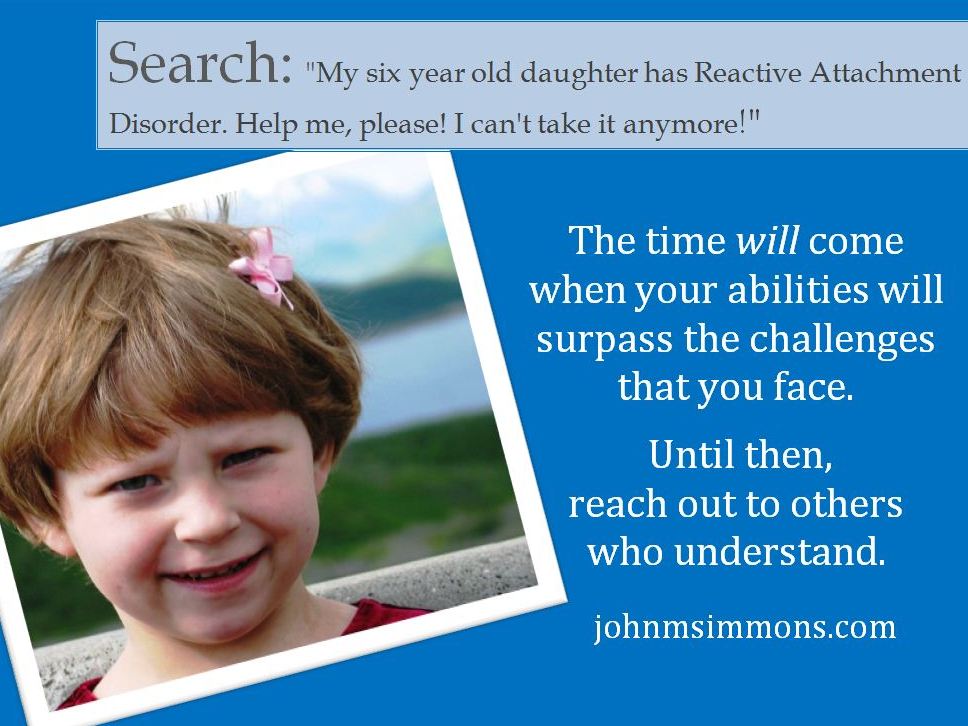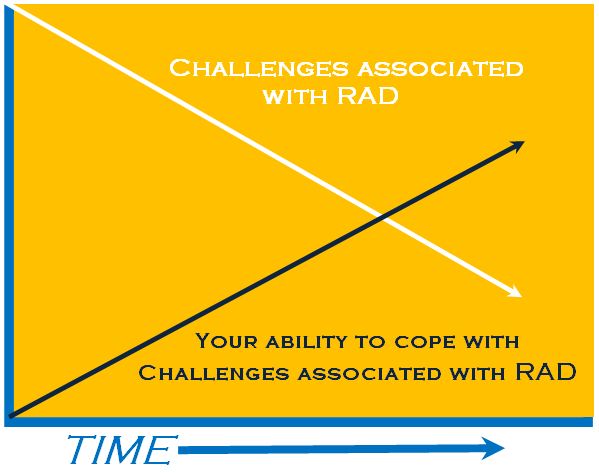Reactive Attachment Disorder Help me, Please!
“My six-year-old daughter has Reactive Attachment Disorder. Help me, please! I can’t take it anymore!” My heart went out as it always does when I read pleas like this one, typed in a search engine that led someone to my blog. I only see the words that were typed into the search engine. No other information is available to me. I always hope that the person found something to help on my blog, or for that matter, anywhere. But my mind goes back to our most desperate days when it was our family that was searching for Reactive Attachment Disorder help.
During those dark hours that spanned years, it felt like we had more judges than Nazi war criminals. Because of the consistency that was necessary to re-program our children into a new reality, almost everyone thought that we were far too strict. Some thought we were monsters. Others, including some of the therapists for our children, thought we were exaggerating. They found it hard to believe that children who were so charming when they were in public, or even in private when away from our family, could be so horrible difficult. The therapists we had at that time did more damage than good. They refused to believe that children with RAD could be such master manipulators that they could “play” adult therapists. For a while, it seemed like Reactive Attachment Disorder help was an oxymoron.
One of the first real tools we found for Reactive Attachment Disorder help was Dr. Gregory Keck’s brilliant book, Adopting the Hurt Child. After reading that book, for the first time, we weren’t questioning our own sanity. For the first time, we felt like a real professional understood the challenges that our children brought with them into our family. That book set us on a path of finding the right therapists for our children. We knew that there must be others like Dr. Keck in our area. Since Adopting the Hurt Child taught us, we knew what we were looking for. And we found them.
Finding the right therapist may have been winning a battle, but there was still a war ahead of us. Reactive Attachment Disorder help gave us tools to assist our children, but those tools were incredibly slow at producing results. With Emily, who was fifteen when she joined our family, we didn’t get enough, soon enough. After multiple suicide attempts and constant abuse to parents and siblings, as well as continual credible threats of homicide, it simply wasn’t safe for us or our daughter for her to remain in our home.
Reactive Attachment Disorder help never seemed like enough, at the time.
Many people considered our adoption of that child a failure. As we first removed her from the home, into an institution, I agreed with them. Even so, though I had given up hope, we didn’t give up trying. We were still Dad and Mom. We still visited. We still participated in meetings that specified her treatment and planned for her future. Reactive Attachment Disorder help helped. As time advanced, our daughter progressed. It took years, but eventually it was safe for her to participate in some family activities.
Not all children who suffer from the effects of Reactive Attachment Disorder need to be removed from the home. We have two other children with RAD who struggled, sometimes bringing excruciating challenges to the family. The difference for us was that keeping them in the home did not put anyone’s life in jeopardy. Even so, it seemed like our children were almost addicted to confrontational settings and would create them at every opportunity. Reactive Attachment Disorder help never seemed like enough, at the time. The progress we saw was so slow we even had to find a new way to measure progress.
As any of us find ourselves in the most difficult circumstances of our lives, we feel like there is no hope. Our brains tell us that we need to quit in order to survive (whether physically, mentally, psychologically or spiritually). Even so, as we stay the course, no matter how difficult it is at the time, progress comes. Not only that, we get stronger. Look at the things that stressed you out before your family added a child who needed Reactive Attachment Disorder help. Look at what stresses you out, now. Those old challenges seem so inconsequential, don’t they? Can you see how far you have come? And if you stick with it, the abilities you now have will continue to increase.
Recently, our family returned from a mini vacation where we were able to see one of our sons graduate from boot camp in the Marines. It was the first time we had been able to include all of our children in the same vacation in seven years. It didn’t come off without a hitch; vacations with children who suffer from Reactive Attachment Disorder never do. Even so, it was a success. It was a great opportunity to look at how far we had come. When my daughter who was five when she joined our family said, “I am so happy to be in this family. You’re the best dad in the world,” I smiled, while thanking her. Then I quickly turned and slipped away to shed a few tears by myself. Later, my daughter who was fifteen when she joined us, and sixteen when she was removed from the home in 2008, approached me. She told me how happy she was that she was no longer lived in Russia and that she could come to America, where people would help her, so she didn’t die, like her mother did. Then she said something in her Russian accent that made me realize that all the Reactive Attachment Disorder help had done its job. “I lov yoo Dad. I lov yoo, Mom. I lov my familee. Familee most eemportant ting.”
Of course me telling you that it gets better doesn’t help you, now. It doesn’t solve the very real and serious problems that you face every day. But go back and look at the chart. The time will come when your abilities surpass the challenges that you face while trying to provide Reactive Attachment Disorder help. Until then, make sure you take some time away from your children who suffer from RAD so you can recharge your batteries. Continue to find more resources to assist you in Reactive Attachment Disorder help. Focus on how far you have come rather than how far you have to go. And this is key: Reach out to others who understand. Whether or not they can tell you anything that will solve your problems, you will find that you are not alone. Sometimes a listening ear is all you need to make it to the next day. If you don’t know who to approach, I know how you feel. I’ve been there, done that and bought the tee shirt. Send me and email. John@JohnMSimmons.com.
Often, readers receive as much help from other readers in the comments section as they do from the blog article, itself. Please be generous with your thoughts and experiences in the comments section. There are lots of people who need what you have to share. This is your chance to help them.
Read more blog articles by John M. Simmons about Disorders/Mental Illness
Return to John M. Simmons’ Blog
Ensure you don’t miss anything by signing up for Our Weekly Newsletter. This is all you need to be qualified for occasional giveaways like the Kindle Fire that Kristy Goulart won in July!


